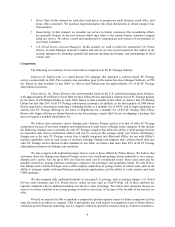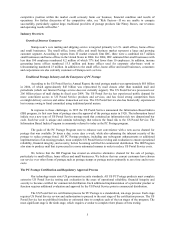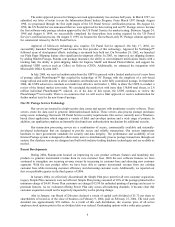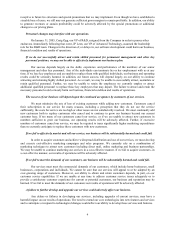Stamps.com 2004 Annual Report Download - page 7
Download and view the complete annual report
Please find page 7 of the 2004 Stamps.com annual report below. You can navigate through the pages in the report by either clicking on the pages listed below, or by using the keyword search tool below to find specific information within the annual report.5
competitive position within the market could seriously harm our business, financial condition and results of
operations. For further discussion of the competitive risks, see “Risk Factors—If we are unable to compete
successfully, particularly against large, traditional providers of postage products like Pitney Bowes, our revenues
and operating results will suffer.”
Industry Overview
Growth of Internet Commerce
Stamps.com’ s core mailing and shipping service is targeted primarily to U.S. small offices, home offices
and small businesses. The small office, home office and small business market represent a large and growing
customer segment. According to reports from IT market research firm IDC, there were a combined 44.7 million
small businesses and home offices in the United States in 2004. For 2004, IDC estimated that small businesses with
less than 100 employees numbered 8.2 million of which 77% had fewer than 10 employees. In addition, income
generating home offices numbered 13.5 million and home offices used for corporate after-hours work or
telecommuting numbered 23 million. In addition to the small office, home office and small businesses, consumers
and corporations are also currently customers of Stamps.com’ s service.
Traditional Postage Industry and the Emergence of PC Postage
According to the US Postal Service Annual Report, the total postage market was approximately $65 billion
in 2004, of which approximately $45 billion was represented by mail classes other than standard mail and
periodicals (which our Internet Postage service does not currently support). The US Postal Service processed over
206 billion pieces of mail during its fiscal year 2004. The US Postal Service has experienced public demand for
more convenient access to US Postal Service products and services, and has faced strong competition from
overnight delivery services and online transaction services. The US Postal Service also has historically experienced
lost revenue owing to fraud committed using traditional postal meters.
In response to these challenges, in 1995 the US Postal Service announced the Information Based Indicia
(IBI) program, its first new form of postage since the approval of the postage meter in 1920. The information based
indicia was a new type of US Postal Service postage mark that contained an information rich two dimensional bar
code. Each bar code is unique and contains technology that reduces the fraud risk to the US Postal Service. The
Information Based Indicia Program is commonly referred to today as the PC Postage program.
The goals of the PC Postage Program were to enhance user convenience with a new access channel for
postage that was available 24 hours a day, seven days a week, while also enhancing the inherent security of the
postage to reduce postage fraud. All PC Postage products, including any subsequent enhancements or additional
implementation of an existing product, must complete US Postal Service testing and evaluation to ensure operational
reliability, financial integrity, and security, before becoming certified for commercial distribution. The IBI Program
also aims to produce mail that is processed in a more automated manner in order to reduce US Postal Service costs.
We believe that the IBI Program has created an attractive alternative channel for the sale of postage,
particularly to small offices, home offices and small businesses. We believe that our current customers have chosen
our service over other forms of postage such as postage stamps or postage meters primarily to save time and to save
costs.
The PC Postage Certification and Regulatory Approval Process
Our technology meets strict US government security standards. All US PC Postage products must complete
extensive US Postal Service testing and evaluation in the areas of operational reliability, financial integrity and
security to become certified for commercial distribution. Each additional implementation of a particular product or
function requires additional evaluation and approval by the US Postal Service prior to commercial distribution.
The US Postal Service certification process for PC Postage is a standardized, ten-stage process. Each stage
requires US Postal Service review and authorization to proceed to the next stage of the certification process. The US
Postal Service has no published timeline or estimated time to complete each of the ten stages of the program. The
most significant stage is the ninth stage, which requires a vendor to complete three phases of beta testing.




















